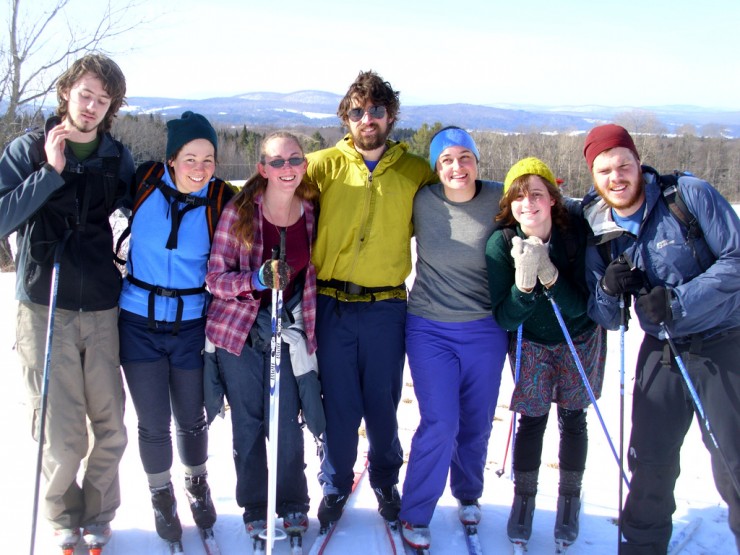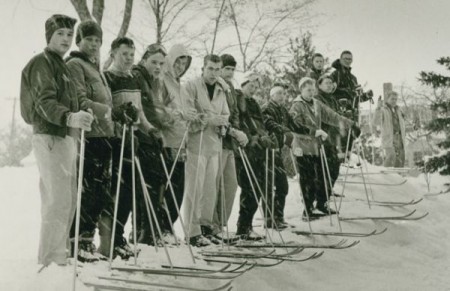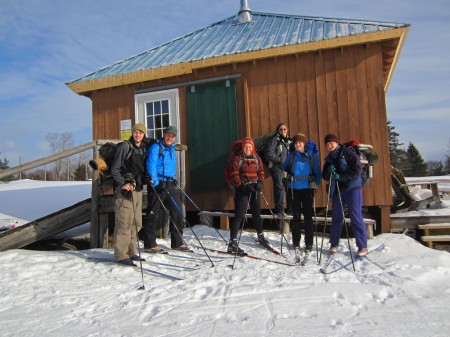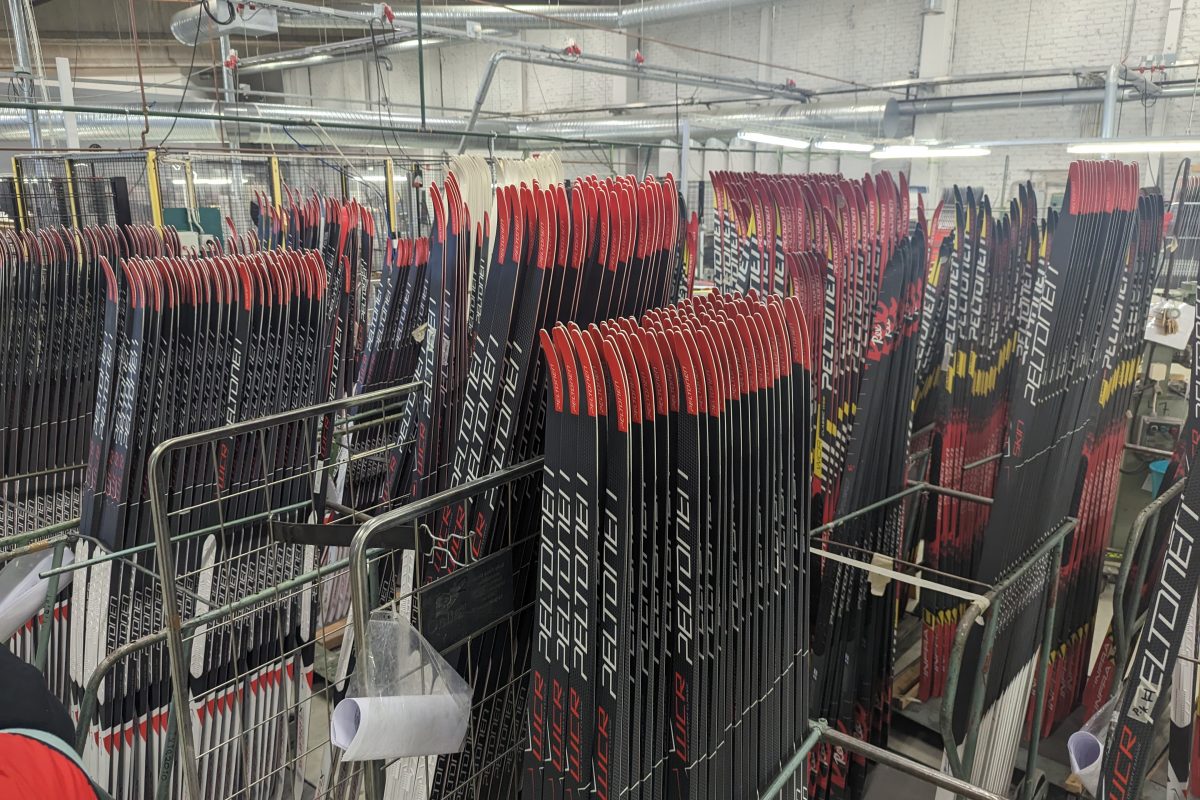
CRAFTSBURY COMMON, Vermont— Over the last decade, college ski teams haven’t exactly been thriving. Sure, the level of skiing by American college skiers at NCAA Championships seems to have taken a huge step up – winning the season-capping races is no longer an honor reserved for European scholarship racers – and college skiers are now more likely to earn a spot on the U.S. Ski Team or compete in World Cups. But for the community as a whole, it’s been a rough go.
All over the country, programs have disappeared. Western State University in Colorado cut its NCAA team, and nordic skiing is now a club. The same happened at Whitman University in Washington and Carleton College in Minnesota. The University of Nevada ski team, one of the most successful of this bunch, was cut in 2009. In 2011, the College of Saint Benedict and Saint John’s University, partner colleges in Minnesota, also eliminated their clubs. That’s just to name a few.
But in a small town in northern Vermont, one college is going against the grain. Sterling College, with an enrollment of about 120 students, announced this week that it was adding a club ski team.
At first glance, Sterling doesn’t seem like the most logical candidate for a ski team. There’s that tiny student body, and a correspondingly sized budget. The college is also focused on the environment, sustainability, and agriculture. In fact, until now it hasn’t had any competitive athletic program at all.
“People often think about Sterling – and we do too – as being very community-oriented and very supportive,” laughed Dean of the College Pavel Cenkl in a recent phone interview. “Some folks might consider that to be antithetical to competition. But what we’ve seen, particularly recently among our students, is that it actually really helps to create a very supportive environment for training and for getting ready for competition.”
Sterling has one other thing going for it, too: it’s based here, right next door to the Craftsbury Outdoor Center and its 85 k of trails. That makes a ski team at Sterling practically a no-brainer.
“We’re really excited about that and it just makes so much sense I think,” Cenkl said. “We’re the only college in the United States that has this size and caliber of a nordic center on its campus – we have trails on campus actually – so we hope it will be a draw for students from outside as well as fill a need for students that we have here… [The team] is open to everybody.”
Anyone who has skied at Craftsbury has likely seen Sterling: situated at the south end of the Common, its classic white New England buildings are part of the town’s character. The Grand Tour trail passes through the village, as does the Catamount Trail. Olympic trials were held here in 1972 – “Bill Koch skied by our buildings,” Cenkl says – and numerous Craftsbury Marathons have started, finished, or passed by the Common.

Sterling was founded in 1958, and the black-and-white photo atop the ‘About’ page of its website features 13 young men on skis. The college is tied to the land in multiple ways; sports is usually more or less incidental. Its mission is framed in the language of environmentalism and good old Vermont stoicism:
“The Sterling College community combines structured academic study with experiential challenges and plain hard work to build responsible problem solvers who become stewards of the environment as they pursue productive lives.”
The college offers four majors: Ecology, Sustainable Agriculture, Outdoor Education, and Environmental Humanities. It features four “living laboratories”: a farm, two swamps, and a sugarbush. Students can choose classes like Environmental Policy and Law, Renewable Energy Design and Analysis, or Draft Horse Management. In January, they could sign up for a two-week cheesemaking intensive at an acclaimed farm in nearby Greensboro.
But the college also requires experiential learning, like a January course where all students try out cross country skiing a few times, among other activities. If they like it, they have been able to take a more advanced class in the winter, and another class even takes a backcountry skiing trip to Idaho.
A ski team will add an important new set of opportunities for students. Starting a team became possible when the Craftsbury Outdoor Center hired a new coach, Zach Russo, for its junior program. Cenkl talked to the Outdoor Center and the organizations agreed to share the new staff member, so that Russo will coach the college’s team a few hours a week as well.
Skiing isn’t the only thing that Sterling is adding; Cenkl is teaching a trail running class which will soon be formalized as a team. Is it the traditional ‘rah rah’ college athletics? Not exactly. But Cenkl sees a use for sports, and is committed to trying to add the ones for which there is student interest.
“We’re not going to field a football team any time soon,” he chuckled “But we’re always open to whatever student interest might be, or if we get faculty with particular expertise or connections.”
So far this fall, he has seen that it makes a big difference to students on campus.
“We met at 5:30 this morning to go running by headlamp at the Outdoor Center trails, and the students absolutely love it,” he said. “One, they get up at 5:30 in the morning to go running, which is great, and we’re working together to prep for a 10 k race that we’ll be doing in Nashua, NH, in November.”

The college is in talks to finalize its membership with the U.S. Collegiate Ski and Snowboard Association (USCSA), a league of club and Division III teams. Cenkl anticipates that Sterling will compete in some league races against schools like Cornell, Clarkson, and Paul Smiths College. But he also hopes they might do some regional citizen’s races in New England, like the Craftsbury Marathon or other competitions in NENSA’s Marathon and Zak Cup series.
Russo, the new coach, competed for and helped head up the Clarkson University ski team when he was a student. As the two men talked, Cenkl found that the atmosphere on Russo’s old team, as well as at USCSA races, was very appealing.
“It was so in keeping with what I had envisioned for Sterling: a very student-oriented, very collegial environment, low-stress,” he explained. “It seems like that league will fit really well with extending the teaching.”
But it will also serve another purpose. Sterling students are traditionally engaged in their community around Craftsbury, but don’t have quite so much contact with other colleges.
“So it’s a way to tie the community together while looking beyond the Northeast Kingdom and making some connections with the outside world,” he said. “We could maybe expand our relationships with other colleges, and build on some of the longer relationships we’ve had with places like the Craftsbury Outdoor Center.”
On the Outdoor Center’s part, it was also a no-brainer to partner with Sterling. Although the Center is best-known in the ski world for its northerly location that assures snow, its additional snowmaking capacities, and its elite Green Racing Project team that has helped launch athletes onto the U.S. national teams for skiing and biathlon, its actual mission is more in line with Sterling’s.
From its website, the Craftsbury Outdoor Center’s mission is:
-
to support and promote participation and excellence in lifelong sports with a special focus on rowing, nordic skiing, and running;
-
to use and teach sustainable practices; and
-
to protect and manage the surrounding land, lake and trails.
In an e-mail this weekend, Judy Geer, who bought the center in 2008 with husband Dick Dressigacker and turned it into a nonprofit, confirmed that the partnership just made sense.
“We’re excited to see them starting this team, and as we started to put together a job that would appeal to a good candidate for our junior coach, it fit well to be able to include the Sterling piece,” she wrote. “We were able to collaborate on attracting and compensating our coach. In terms of the mission, it really fits the first prong.”
Sterling has an advantage in how well its mission matches with Geer’s goals, but its reasons for starting a ski team are also important in its success. Perhaps the struggles faced by many former NCAA teams have more to do with budget and scale.
Starting a club team isn’t difficult, Cenkl reported; aside from the dialogues on campus, he is mostly responsible for joining the USCSA, which is “not particularly onerous, as opposed to the NCAA or something.”
If your goal is to win a Division I Championship? Yes, that will be expensive, difficult, and complicated. But that shouldn’t be the only reason that colleges field ski teams.
“It seems like a natural extension of our ecological focus, community orientation, and environmental awareness,” Cenkl said. “And extracurricular activities can try to formalize your goals.”
Chelsea Little
Chelsea Little is FasterSkier's Editor-At-Large. A former racer at Ford Sayre, Dartmouth College and the Craftsbury Green Racing Project, she is a PhD candidate in aquatic ecology in the @Altermatt_lab at Eawag, the Swiss Federal Institute of Aquatic Science and Technology in Zurich, Switzerland. You can follow her on twitter @ChelskiLittle.




One comment
johnchiarella
October 30, 2013 at 8:45 pm
USCSA is a wonderful choice for schools and college skiers. After skiing at one of those small-under funded and now defunct division 1 teams, and then coaching in D1, D2, and NCSA (now USCSA); I had great experiences everywhere, but never saw kids enjoying Nordic racing more than at USCSA races. The atmosphere at USCSA races was supportive, collegial, and some of the most fun I ever had coaching and skiing was running after race clinics where kids from all the schools would join in, and we would work on technique, skills, and just have fun on skis. Everyone participated at their own level in clinics and races, and that ranged from those who could be on D1 teams to first time skiers. I think the skiers will love it. Best of luck.